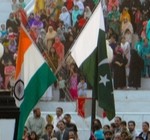The run-up to the talks was low key. Neither side raised hopes of headline-grabbing developments. The absence of drama or excitement surrounding the June 23-24 round of talks between Nirupama Rao and Salman Bashir, the foreign secretaries of India and Pakistan respectively, helped focus on the progress achieved by both sides in getting on with the agenda.
Consequently, the notable achievement of the meeting in Islamabad between Rao and Bashir was to stabilise confidence-building measures (CBMs) on all the three tracks – peace and security, Jammu and Kashmir, and friendly exchanges. Most particularly, they concentrated on measures to minimise the nuclear threat and reviewed the existing situation. This cleared the decks for expert-level groups of the two countries to consider further nuclear confidence-building measure before their foreign ministers meet in July.
Nuclear confidence-building measures appear to be remote achievements, and may not create the kind of buzz that people-to-people initiatives can give rise to. Yet, the importance of these cannot be overstated, especially at a time when the danger of Pakistan’s nuclear weapons falling into the wrong hands is more real than at any time before. Today, threat of a nuclear breakdown in Pakistan – a global disaster scenario intensified after the jihadi attack on Pakistani’s naval facilities in Mehran – will affect India the most. It confirmed that the country’s armed forces have been infiltrated by terrorists and their accomplices; that jihadis are embedded in sensitive establishments of the army; and, that the presence of U.S. and Chinese personnel does not intimidate the nexus between jihadis and their partners in uniform. Worse could yet come, such as the operationalisation of the Islamist terror network in the Pakistani armed forces that could lead to the breakdown of the command-and-control structure of a military facility in the hands of non-state actors.
Alongside this alarming scenario is the existence of short-range missiles used as artillery with conventional warheads under the charge of local battlefield commanders in both India and Pakistan. Such improvised artillery can undermine deterrence at lower levels. Unlike nuclear weapons systems, whose use must be pre-authorised, the short-range missiles can be used as battlefield weapons under the orders of inexperienced field commanders, which carries the danger of accidental and inappropriate deployment. In the case of Pakistan, the jihadi links of officers have increased fears of a mischievous use of these missiles.
It is against this backdrop that the latest nuclear confidence-building measures have to be viewed as a stabilising force for enhanced security, and safety of nuclear facilities. Former Foreign Secretary Lalit Mansingh, who has been pushing for prioritising the nuclear dialogue, considers these measures to be the most purposeful result of the recent talks. “Nuclear confidence-building has been the centrepiece of India-Pakistan Track II processes, and are an issue on which both sides have progressed remarkably well,” says Mansingh.
Even so, India had to be “extremely cautious” about pursuing these goals. Post-Abbottabad, it is not only anti-American sentiments that run deep in Pakistan: India is perceived, by many Pakistanis, to be a greater threat to Pakistan than Al Qaeda or the Taliban, clouding the atmosphere for the civilian government’s talks with India. In the circumstances, Indian postures, language and tone assume greater importance than the content at issue.
On balance, the civilian government in Islamabad has acquitted itself extremely well and given New Delhi the satisfaction of plain-speaking, consolidating the gains since the February talks in Thimpu between the foreign secretaries, followed by the two prime ministers meeting at the cricket match in March and the home, commerce and defence secretaries meeting in end March, April and May respectively. India and Pakistan seem to be moving forward in areas which promise real progress “without being held hostage to India’s core issue of terrorism or Pakistan’s core concern of Kashmir. This is no mean achievement,” notes Mansingh. The talks were held in a pleasant atmosphere and went off well, a marked improvement for bilateral relations. Fresh ideas for further confidence-building measures were proposed such as the removal of “unacceptable visa restrictions” like single-entry, single-city-only permits, can go a long way in transforming people-to-people relations favourably.
In addition to the visa regime, the changes proposed over the weekend meeting include: the agreement to prevent ‘situations’ at sea such as the recent “brush” between the warships of India and Pakistan in the Gulf of Aden, more cross-Line Of Control exchanges, a greater frequency of Srinagar-Muzaffarabad bus services, a new Kargil-Skardu bus service, increasing trading days from two to four per week and trading posts – there are currently only two, Chakan-da-Bagh in the Poonch district of Jammu, and Salamabad in the Baramulla district of the Kashmir valley – and more points of people-to-people and institutional interactions, are all good signs.
Thankfully, Rao did not focus single-mindedly on terrorism – it would only have blocked progress on other tracks. This realisation, perhaps, restrained Bashir from also pressing Pakistan’s predictable obstructive line on Kashmir.
If these talks signify a resolve not to let the problem of “core issues” preclude New Delhi and Islamabad from proceeding with achievable outcomes on other diplomatic tracks, then surely history will show that this June meeting may the turning point in the Subcontinent’s geopolitics.
Shastri Ramachandaran is a veteran journalist specializing in foreign affairs and geopolitics.
This article was exclusively written for Gateway House: Indian Council on Global Relations. You can read more exclusive content here.
For interview requests with the author, or for permission to republish, please contact outreach@gatewayhouse.in.
© Copyright 2011 Gateway House: Indian Council on Global Relations. All rights reserved. Any unauthorized copying or reproduction is strictly prohibited.


